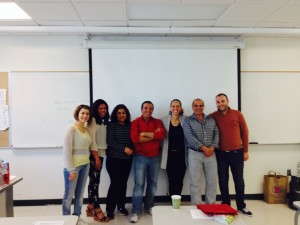The Journal of Critical Mixed Race Studies inaugural issue is now available
Journal of Critical Mixed Race Studies
Volume 1, Number 1 (2014-01-30)
ISSN: 2325-4521
Laura Kina, Associate Professor Art, Media and Design and Director Asian American Studies
DePaul University, Chicago, Illinois
G. Reginald Daniel, Professor of Sociology
University of California at Santa Barbaral
Saya Woolfalk, video still from “The Emphathics,” 2012.
The Journal of Critical Mixed Race Studies inaugural issue is now available. Volume 1, No. 1, 2014 “Emerging Paradigms in Critical Mixed Race Studies” It has been a long journey from the publication of Maria Root’s groundbreaking and award-winning anthology Mixed People in America (1992) to the inauguration of the Journal of Critical Mixed Race Studies. We would like to thank all of our contributors, volunteers, and editorial review board for their hard work and patience. We hope you enjoy this issue of the journal and find it an informative resource on the topic of mixed race identities and experiences.
G. Reginald Daniel, Editor in Chief
Laura Kina, Managing Editor
The Journal of Critical Mixed Race Studies (JCMRS) is a peer-reviewed online journal dedicated to Critical Mixed Race Studies (CMRS). Launched in 2011, it is the first academic journal explicitly focused on Critical Mixed Race Studies. Sponsored by UC Santa Barbara’s Sociology Department, JCMRS is hosted on the eScholarship Repository, which is part of the eScholarship initiative of the California Digital Library.
- Front Matter
- Cover Art
- Table of Contents
- Editor’s Note / Daniel, G. Reginald
- Emerging Paradigms in Critical Mixed Race Studies / Daniel, G. Reginald; Kina, Laura; Dariotis, Wei Ming; Fojas, Camilla
- Appendix A: Publications from 1989 to 2004 / Riley, Steven F.
- Appendix B: Publications from 2005 to 2013 / Riley, Steven F.
- “Historical Origins of the One-Drop Racial Rule in the United States” / Jordan, Winthrop D. (Edited by Spickard, Paul)
- “Reconsidering the Relationship Between New Mestizaje and New Multiraciality as Mixed-Race Identity Models / Turner, Jessie D.
- “Critical Mixed Race Studies: New Directions in the Politics of Race and Representation / Jolivétte, Andrew J.
- “‘Only the News They Want to Print’: Mainstream Media and Critical Mixed-Race Studies” / Spencer, Rainier
- “The Current State of Multiracial Discourse” / McKibbin, Molly Littlewood
- “Slimy Subjects and Neoliberal Goods: Obama and the Children of Fanon” / McNeil, Daniel
- Stephen Murphy-Shigematsu, When Half Is Whole: Multiethnic Asian Americans Identities / Crawford, Miki Ward
- Ralina Joseph, Transcending Blackness: From the New Millennium Mulatta to the Exceptional Multiracial / Elam, Michele
- Greg Carter, The United States of the United Races: A Utopian History of Racial Mixing / Mount, Guy Emerson
- Rudy P. Guevarra, Jr., Becoming Mexipino: Multiethnic Identities and Communities in San Diego / Schlund-Vials, Cathy J.
- About the Contributors


